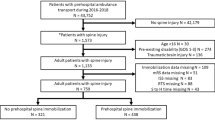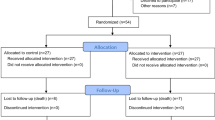Abstract
Study design:
Retrospective cohort study.
Objectives:
The aims of the current study were (i) to analyze prehospital and emergency room treatment of patients with acute traumatic spinal cord injury (SCI) and (ii) to analyze whether recommendations given by the current guidelines are implemented.
Setting:
German level I trauma center.
Methods:
All patients suffering from traumatic SCI who were initially surgically treated in our hospital in the period from January 2008 to December 2013 were included in this study. Available data documented as a standard procedure in our trauma center included patient’s demographic and medical information, as well as trauma mechanisms, cause of injury, neurological diagnosis and detailed clinical information about prehospital and early hospital management procedures. Retrospectively, statistical analysis was performed to describe spinal immobilization rates, transportation times and methylprednisolone administration.
Results:
A total of 133 patients (mean age: 50.5±21.2 years) met the inclusion criteria. Immobilization was performed on 69.9% of the patients with traumatic SCI. From 60 patients suffering from cervical traumatic SCI, 47 patients had a cervical collar. Full immobilization was only performed in 34 of these 60 patients. Mean time from accident site to emergency room was 61.3±28.7 min. In 25 out of the 133 patients included in the current study, early surgery was not possible because of insufficient circulation and/or increased intracranial pressure. A total of 108 patients could be prepared for early surgery within 322.8±254.1 min after the accident.
Conclusion:
The current study shows that recommendations of the current literature and guidelines are mostly followed.
Similar content being viewed by others
Log in or create a free account to read this content
Gain free access to this article, as well as selected content from this journal and more on nature.com
or
References
Crosby ET . Airway management in adults after cervical spine trauma. Anesthesiology 2006; 104: 1293–1318.
Stephan K, Huber S, Haberle S, Kanz KG, Buhren V, van Griensven M et al. Spinal cord injury-incidence, prognosis, and outcome: an analysis of the TraumaRegister DGU. Spine J 2015; 15: 1994–2001.
Hauswald M, Ong G, Tandberg D, Omar Z . Out-of-hospital spinal immobilization: its effect on neurologic injury. Acad Emerg Med 1998; 5: 214–219.
Hauswald M, Braude D . Spinal immobilization in trauma patients: is it really necessary? Curr Opin Crit Care 2002; 8: 566–570.
McDonald NE, Curran-Sills G, Thomas RE . Outcomes and characteristics of non-immobilised, spine-injured trauma patients: a systematic review of prehospital selective immobilisation protocols. Emer Med J, (e-pub ahead of print 23 September 2015; doi:10.1136/emermed-2015-204693).
Felleiter P, Reinsberger C, Springe D, Plunien H, Baumberger M . Die präklinische Diagnose der traumatischen Querschnittlähmung - eine prospektive Studie an 100 Patienten. Anästhesiol Intensivmed Notfallmed Schmerzther 2006; 41: 9–13.
Brunette DD, Rockswold GL . Neurologic recovery following rapid spinal realignment for complete cervical spinal cord injury. J Trauma 1987; 27: 445–447.
Farmer J, Vaccaro A, Albert TJ, Malone S, Balderston RA, Cotler JM . Neurologic deterioration after cervical spinal cord injury. J Spinal Disord 1998; 11: 192–196.
Toscano J . Prevention of neurological deterioration before admission to a spinal cord injury unit. Paraplegia 1988; 26: 143–150.
Harrop JS, Sharan AD, Vaccaro AR, Przybylski GJ . The cause of neurologic deterioration after acute cervical spinal cord injury. Spine 2001; 26: 340–346.
Unfallchirurgie DGf. S3 – Leitlinie Polytrauma/Schwerverletzten-Behandlung 2011; AWMF-Register Nr. 012/019.
Walters BC, Hadley MN, Hurlbert RJ, Aarabi B, Dhall SS, Gelb DE et al. Guidelines for the management of acute cervical spine and spinal cord injuries: 2013 update. Neurosurgery 2013; 60 (Suppl 1): 82–91.
Curt A. Neurotraumatologie und Erkrankungen von Wirbelsäule und Nervenwurzel - Querschnittlähmung. In: Diener HC, Weimar C (eds). Leitlinien für Diagnostik und Therapie in der Neurologie. Thieme Verlag: Stuttgart, Germany, 2012..
Fehlings MG, Cadotte DW, Fehlings LN . A series of systematic reviews on the treatment of acute spinal cord injury: a foundation for best medical practice. J Neurotrauma 2011; 28: 1329–1333.
Dobran M, Iacoangeli M, Nocchi N, Di Rienzo A, di Somma LG, Nasi D et al. Surgical treatment of cervical spine trauma: our experience and results. Asian J Neurosurg 2015; 10: 207–211.
Bourassa-Moreau E, Mac-Thiong JM, Feldman DE, Thompson C, Parent S . Non-neurological outcomes after complete traumatic spinal cord injury: the impact of surgical timing. J Neurotrauma 2013; 30: 1596–1601.
Fehlings MG, Vaccaro A, Wilson JR, Singh A, D WC, Harrop JS et al. Early versus delayed decompression for traumatic cervical spinal cord injury: results of the Surgical Timing in Acute Spinal Cord Injury Study (STASCIS). PLoS One 2012; 7: e32037.
Grossman RG, Frankowski RF, Burau KD, Toups EG, Crommett JW, Johnson MM et al. Incidence and severity of acute complications after spinal cord injury. J Neurosurg Spine 2012; 17 (1 Suppl): 119–128.
Kwan I, Bunn F, Roberts I . Spinal immobilisation for trauma patients. Cochrane Database Syst Rev 2009, CD002803.
Craig GR, Nielsen MS . Rigid cervical collars and intracranial pressure. Intensive Care Med 1991; 17: 504–505.
Hunt K, Hallworth S, Smith M . The effects of rigid collar placement on intracranial and cerebral perfusion pressures. Anaesthesia 2001; 56: 511–513.
Papadopoulos MC, Chakraborty A, Waldron G, Bell BA . Lesson of the week: exacerbating cervical spine injury by applying a hard collar. BMJ 1999; 319: 171–172.
Clarke A, James S, Ahuja S . Ankylosing spondylitis: inadvertent application of a rigid collar after cervical fracture, leading to neurological complications and death. Acta Orthop Belg 2010; 76: 413–415.
Hamilton RS, Pons PT . The efficacy and comfort of full-body vacuum splints for cervical-spine immobilization. J Emerg Med 1996; 14: 553–559.
Johnson DR, Hauswald M, Stockhoff C . Comparison of a vacuum splint device to a rigid backboard for spinal immobilization. Am J Emerg Med 1996; 14: 369–372.
Luscombe MD, Williams JL . Comparison of a long spinal board and vacuum mattress for spinal immobilisation. Emerg Med J 2003; 20: 476–478.
Chandler DR, Nemejc C, Adkins RH, Waters RL . Emergency cervical-spine immobilization. Ann Emerg Med 1992; 21: 1185–1188.
Horodyski M, DiPaola CP, Conrad BP, Rechtine GR 2nd . Cervical collars are insufficient for immobilizing an unstable cervical spine injury. J Emerg Med 2011; 41: 513–519.
Hostler D, Colburn D, Seitz SR . A comparison of three cervical immobilization devices. Prehosp Emerg Care 2009; 13: 256–260.
Connor D, Greaves I, Porter K, Bloch M . Pre-hospital spinal immobilisation: an initial consensus statement. Emerg Med J 2013; 30: 1067–1069.
Gerndt SJ, Rodriguez JL, Pawlik JW, Taheri PA, Wahl WL, Micheals AJ et al. Consequences of high-dose steroid therapy for acute spinal cord injury. J Trauma 1997; 42: 279–284.
Bracken MB, Shepard MJ, Collins WF, Holford TR, Young W, Baskin DS et al. A randomized, controlled trial of methylprednisolone or naloxone in the treatment of acute spinal-cord injury. Results of the Second National Acute Spinal Cord Injury Study. N Engl J Med 1990; 322: 1405–1411.
Kleber C, Lefering R, Kleber AJ, Buschmann CT, Bail HJ, Schaser KD et al. Rettungszeit und Überleben von Schwerverletzten in Deutschland. Unfallchirurg 2013; 116: 345–350.
Acknowledgements
We thank Maike Küffer and Johannes Gladitz for statistical expertise, as well as Claudia Thompson for revision of the manuscript.
Author information
Authors and Affiliations
Corresponding author
Ethics declarations
Competing interests
The authors declare no conflict of interest.
Rights and permissions
About this article
Cite this article
Kreinest, M., Ludes, L., Türk, A. et al. Analysis of prehospital care and emergency room treatment of patients with acute traumatic spinal cord injury: a retrospective cohort study on the implementation of current guidelines. Spinal Cord 55, 16–19 (2017). https://doi.org/10.1038/sc.2016.84
Received:
Revised:
Accepted:
Published:
Issue date:
DOI: https://doi.org/10.1038/sc.2016.84
This article is cited by
-
Comparison of different tracheal intubation methods for unstable upper cervical spine injuries in a human cadaver model
Scientific Reports (2025)
-
Improving quality of care in traumatic spinal column/spinal cord injuries (TSC/SCI) in Iran: a policy brief
Spinal Cord Series and Cases (2024)
-
Epidemiology and predictors of traumatic spine injury in severely injured patients: implications for emergency procedures
European Journal of Trauma and Emergency Surgery (2022)
-
Konventionelle Intubation und Larynxtubus bei Halswirbelsäuleninstabilität
Der Anaesthesist (2019)
-
Spinal movement and dural sac compression during airway management in a cadaveric model with atlanto-occipital instability
European Spine Journal (2018)



